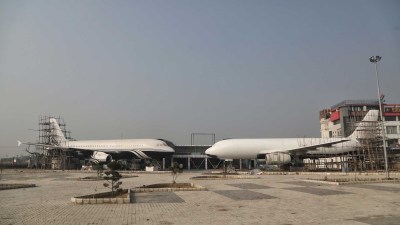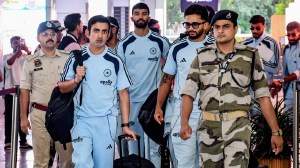Between Black and White
Raghu Rai captures the scatological and the sacred of this wide-angled land

It is the sort of picture you could skip in a wedding album — a clumsy photo of the newlyweds, with the bride’s face turned away from the camera. But flip back to the page, and you might notice the anguish in that half-averted face. It’s the anguish of every girl leaving the familiar for the unknown — alone. Yet no one else in the photograph seems to share the young woman’s sorrow. Her mother is looking away, distracted by a guest, the groom is marching manfully on, heedless of this new companion clutching timidly at his shawl, and the thronging relatives are all wrapped up in their private worlds.
If a good picture is worth a thousand words, as they say, then each of Raghu Rai’s photographs is a novella that is at once timeless and contemporary, personal and impersonal, as raw as meat in a butcher shop, and as subtle as haiku poetry.
Maybe that’s why Rai’s challenge has always been India, a country that simply defies description. A country so wide-angled and so overwhelmingly visual that extracting its essence is like distilling a tonne of gently rotting roses into a teaspoon. This time, he has done it with characteristic uniqueness — black-and-white images of our Technicolor nation, in a lavish tome called Raghu Rai’s India.
And if the title sounds vaguely conceited or proprietary, I think, they are liberties he has earned. One of the world’s most talented photographers according to none other than Henri Cartier-Bresson, this man nevertheless believes the photographer’s job is purely functional: “To cut out a frame-sized slice from the world around him, so faithfully and honestly, that were he to put it back, life and the world would begin to move again without a stumble.”
Indeed, most of Raghu Rai’s characters — human, animal and avian — seem to wander into his photographs quite by accident, lives momentarily captured in parenthesis, before they seamlessly head out. Part of the whole, yet providing a subtext that not only enriches the story but also sends it scurrying in different directions, like a wayward delta burrowing through layers of fertile silt and labyrinthine marsh.
Yet Rai’s work is not about technique, nor about pictures, words, thoughts or stories. It is, ultimately, a journey into the human spirit, as you can plainly see in “Rush For A Local Train” (Mumbai, 1996) (above). On either side of the frame is a blur of sprinting figures, life bound by the spatial and temporal. In the middle of this cosmic chaos, like a tranquil island, sit three oblivious commuters in sharp focus, quietly reading the morning papers. Here only the Present prevails, the reality of the moment.
The problem with turning photography to philosophy is obvious: a realisation that it is not the filters in the camera, but those in the mind that pose the biggest threat to “faithfulness and honesty”.
In “Women at Banganga” (Kalighat, Kolkata, 2005), a group of women lovingly worships a stone deity surrounded by mounds of rotting refuse and urban decay. The contrast is commonplace, almost stereotypical, yet with Rai, goddess and garbage, the sacred and the scatological somehow manage to transcend their mundane duality.
The trick, you see, is to simply reflect reality like a mirror, and resist that very human urge to judge or interpret. Because photography at its best, says Raghu Rai, is like the soul: it need not always be explained.
Photos


- 01
- 02
- 03
- 04
- 05





























